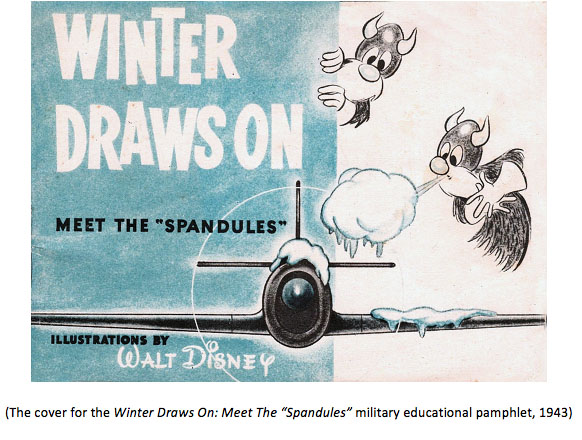
Nowadays, if you mention the term Gremlin most people will think of the Chris Columbus written, Joe Dante directed 1984 hit film Gremlins from executive producer Steven Spielberg. Some prior generations may even remember the terrifying Twilight Zone episode, Nightmare at 20,000 Feet from 1963, featuring William Shatner as airline passenger Robert Wilson who sees a gremlin on the plane’s wing. And the term itself, gremlins, has become part of the English lexicon.
But of course, if you are a Disneyphile, you are likely aware of British author Flight Lieutenant Roald Dahl’s The Gremlins, which Walt Disney acquired the rights to in 1942. Dahl’s story is about the mythical, mischievous little creatures that reportedly wreak havoc on aircraft. Gremlins were a common known reason for mishaps in the British Royal Air Force and aviation in general. Disney artists Bill Justice and Al Dempster created the illustrations for Dahl’s 1943 book The Gremlins published by Random House.
Walt Disney spent considerable time developing an animation and live-action feature as well as a straight all animated film. Eventually, the feature ideas were scrapped in favor of a short, and, after spending $50,000,(1) the project was shelved altogether in December 1943. There is no definitive reason, only speculation on why the film was canceled. Some claim there was war film fatigue among theatergoers; others say that the storyline could not be cracked satisfactorily for a standalone feature or short. The characters did spawn merchandise and were used for military insignia and educational materials.
One little known use was of the Spandule characters, which appear briefly in Dahl’s book. The Spandules are described by who they are, where they came from, and what they do to planes. The Spandules are said to be cousins to the Gremlins. They are considered a race of “sentient humanoid beings”(2) that live in cumulus clouds above thirty thousand feet and eat hailstones all day.(3) These creatures are three times bigger than Gremlins yet flat and hairy with Viking-like horned helmets.(4)
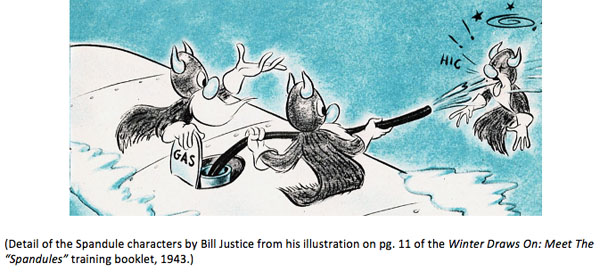
According to Disney Historian Jim Korkis, “The Spandule is similar in facial design to the other gremlins developed by the Disney Studios, but there are also some significant differences. They have two curved horns coming out of their head, making them look like small Vikings. They have big round noses and long white beards. Their bodies are covered with long hair, and they apparently have no legs or feet, just trailing hair that bends like a tail. They wear big white gloves to distinguish their hands that have long thin fingers and a thumb.”(5)
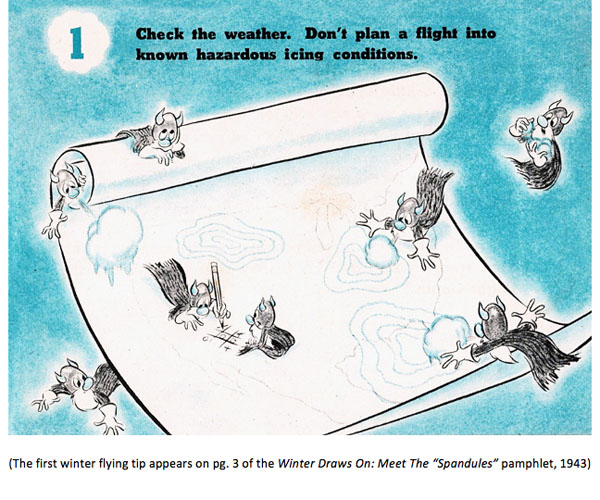
Aside from an minor appearance in Dahl’s The Gremlins, the Spandules are prominently featured in a training pamphlet titled Winter Draws On: Meet The “Spandules,” published in 1943 by the Safety Education Division Flight Control Command of the United States Army Air Forces. The twenty-four-page, plus cover, training pamphlet was designed to educate pilots on the dangers of winter flying, like checking the weather for known icing conditions, watching out for ice formation on the wings fuselage, and other tips. Each tip is accompanied by handsome cartoon illustrations created by Walt Disney Productions.
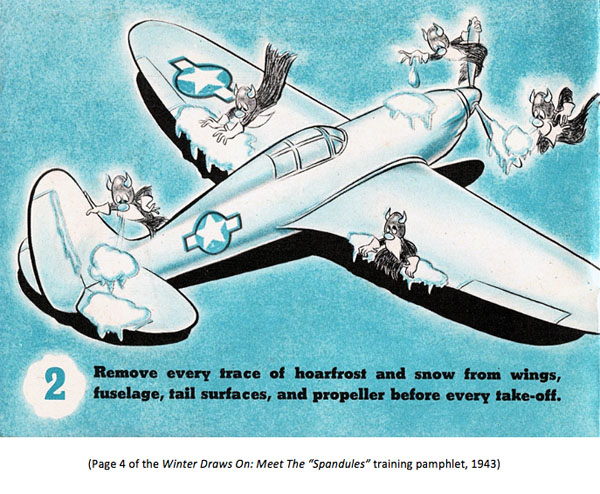
The opening text on pages one and two says it all; “In this book for the first time is pictured a close relative of the Gremlin, the “Spandule.” These little fellows inhabit the air space above 30,000 feet except in winter time [sic] when they come down to lower altitudes and have been known to play around on the ground. Although not mean at heart, these little guys are forced by their very nature to do a lot of things to get a pilot in Trouble.”(6)
The text goes on to state, “Whenever an airplane enters their domain they pounce aboard. They like to test a guy out. If he is on his toes they probably won’t bother him much, but if he looks sound asleep or a little thick between the ears they are almost sure to plaster his wings with ice, load down his propeller, and do all sorts of tricks that can be real serious.”(7)
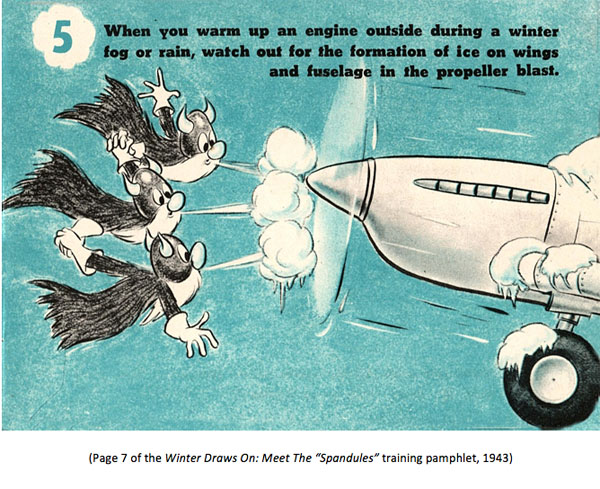
“If you know where to look for Spandules and if you keep a close watch for the first evidence of their handiwork, you can usually avoid a run-in with them. This book will help you do that.”(8)
“The life-like pictures of Spandules which appear in this book were created by Walt Disney at the invitation of Flight Control Command.”(9)
Aside from the opening, the booklet is light on text but profusely illustrated by Disney artist Bill Justice.(10) With a career at Disney spanning more than forty years, Justice is credited with some fifty-seven shorts and nineteen animated feature films.(11) He is known for his animation of Thumper in Bambi (1942) and the Chip and Dale characters.(12)

“Bill told me he loved doing the pamphlet for two reasons,” Jim Korkis said. “First, he always liked being given something different to do, as evidenced by his later work with X. Atencio on stop motion animation. Second, because he created the definitive design of Disney’s Gremlins, he always loved drawing them. Even decades later, he could still draw them from memory, as I discovered when he did a sketch for me that I later used on my book Gremlin Trouble.” (13)

Justice also had extensive accomplishments as an Imagineer at Walt Disney Imagineering in the latter part of his career at Disney. He joined Imagineering in 1965 and programed the Audio-Animatronic figures for Great Moments with Mr. Lincoln, Mission to Mars, Pirates of the Caribbean, Haunted Mansion, Country Bear Jamboree, and America Sings. Justice also was part of the team that created Walt Disney World’s The Hall of Presidents attraction.(14)
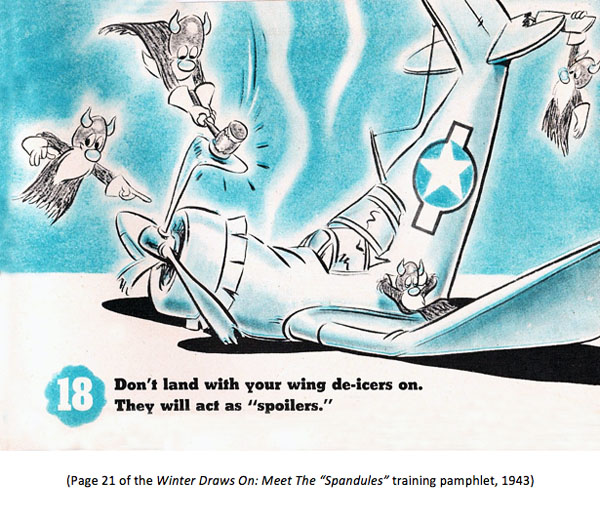
During the WWII era, Justice, like other artists at the Walt Disney Studios, contributed his talents to many war-related films, including Der Fuehrer’s Face (1942), Victory Through Air Power (1943), Victory Vehicles (1943), The Winged Scourge (1943), and Home Defense (1943). And aside from the Winter Draws On: Meet The “Spandules” pamphlet, he did other WWII illustrations, including military insignia.
These types of assignments could be a single drawing for one thing or another that might require anywhere from an hour to a day to complete. Even though the Studio had a Publicity Production Department with artists like Hank Porter, Roy Williams, George Goepper, Ed Parks, and Van Kaufman creating many of the WWII insignia, the need was always more significant than what they could always produce.(15)
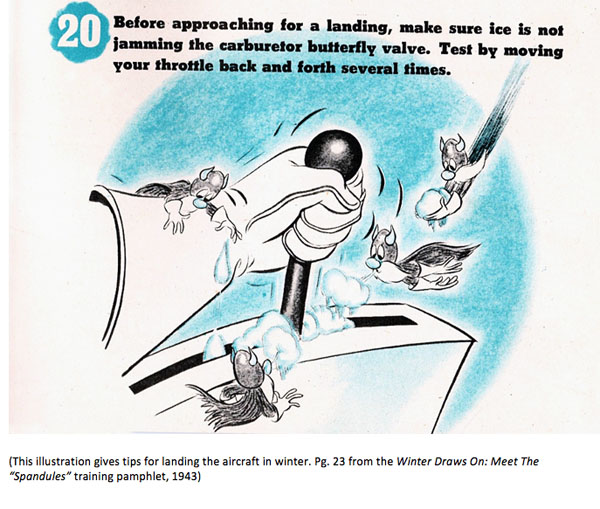
This flood of “one-off” work was typical of how the Studio operated. Artists were rarely idle and often were asked to do small assignments between or even during film projects. These requests have always been the case, even today. Through the years, the Publicity Production Department has evolved into various iterations, including Animation Services and Special Projects. These groups served an essential purpose in handling the ancillary production needs and oddball requests that the Studio continuously receives.
The pamphlet even touched on “Cold Weather Health” by making recommendations for exercise and nutrition during the winter months. “Fats and sugars are heat-producing foods. Eat more of them during the cold months.” Further, the text went on to state, “Get as much exercise as your flying schedule will allow. Winter exercise is even more important than summer exercise. Watch your ears, nose and throat.” Simple and to the point text reinforced the importance of nutrition and exercise, especially during the winter.
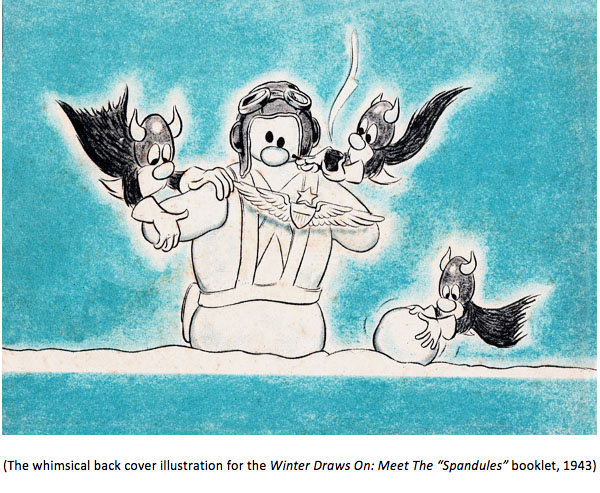
I can imagine that Justice had fun working on the Winter Draws On: Meet The “Spandules” booklet. The drawings have just the right mix of whimsy and serious educational points. He was able to take what is dry information and make it engaging to the reader. Each drawing is making a clear visual statement that supports the written text. His pictures have clean compositions with solid silhouettes that give the viewer instant recognition of the visual message. That’s all that was needed for this handy 4 ½ X 6 inch booklet(16) to serve as an in-cockpit checklist for pilots during the winter months.

Walt Disney had another reason to do the Winter Draws On: Meet The “Spandules” pamphlet for United States Army Air Forces. That was to establish copyright on his interpretation of these Gremlin characters. That is also likely why he approved these characters for other merchandise like comic books, puzzles, plush dolls, and even a Life Savers advertisement.(17)
The Winter Draws On: Meet The “Spandules” booklets are a very collectible form of Disney WWII ephemera and are still readily available. They show up in auctions occasionally, and even a cursory search online will turn up several for sale at any given time. It is a historical artifact from the Walt Disney Studios during the WWII years.
This is another example of the variety of assignments that Walt Disney Productions was called upon to do during WWII. It shows the Studios and its artists importance to the war effort and how those not fighting on the frontlines still contributed in important ways on the home front. Bill Justice and the other Disney artists were indeed a facet of the greatest generation.
©2021 David A. Bossert
FOOTNOTES
1 – Flight Lieutenant Roald Dahl, The Gremlins, Dark Horse Books, 2006, pg. viii
2 – Scrooge McDuck Wiki, Spandules, description.
3 – Flight Lieutenant Roald Dahl, The Gremlins, Dark Horse Books, 2006, pg. 26
4 – Ibid
5 – Email exchange between the author and Jim Korkis, April 2021.
6 – Research, Winter Draws On: Meet the Spandules pamphlet, 1943, pg. 1.
7 – Ibid
8 – Ibid, pg.2
9 – Ibid
10 – Gremlins/Spandules Booklets, Heritage Auctions, HA.com
11 – IMDB, Bill Justice, https://www.imdb.com/name/nm0433143/
12 – Walt Disney Archives, Disney Legends, Bill Justice.
13 – Research, Email exchange between the author and Jim Korkis, April 2021.
14 – Ibid
15 – David Lesjak, Service with Character: The Disney Studios & World War II, Theme Park Press, 2014, pg. 115
16 – Winter Draws On: Meet The “Spandules” booklet, 1943, authors collection.
17 – Research, Email exchange between the author and Jim Korkis, April 2021.


 David A. Bossert is an award-winning artist, filmmaker, and author. He received his B.A. from CalArts School of Film and Video with a major in Character Animation. As a 32-year veteran of The Walt Disney Company, he contributed his talents to The Black Cauldron (1985), Who Framed Roger Rabbit (1988), The Little Mermaid (1989), Beauty and the Beast (1991), Aladdin (1992), Tim Burton’s The Nightmare Before Christmas (1993), The Lion King (1995), Fantasia/2000 (1999), and the Academy Award-nominated shorts Runaway Brain (1995), Dali/Disney Destino (2003), and Lorenzo (2004), among many others. Bossert is now an independent producer, creative director, and writer.
David A. Bossert is an award-winning artist, filmmaker, and author. He received his B.A. from CalArts School of Film and Video with a major in Character Animation. As a 32-year veteran of The Walt Disney Company, he contributed his talents to The Black Cauldron (1985), Who Framed Roger Rabbit (1988), The Little Mermaid (1989), Beauty and the Beast (1991), Aladdin (1992), Tim Burton’s The Nightmare Before Christmas (1993), The Lion King (1995), Fantasia/2000 (1999), and the Academy Award-nominated shorts Runaway Brain (1995), Dali/Disney Destino (2003), and Lorenzo (2004), among many others. Bossert is now an independent producer, creative director, and writer.













































































I’m sure Roald Dahl was perfectly aware that cumulus clouds don’t occur at 30,000 feet or produce hailstones. Those RAF officers had to have a thorough understanding of all weather conditions and their effects as a matter of life of death. Arthur C. Clarke’s novel “Glide Path” is a fictionalised account of his experience in developing ground-based radar at an RAF base during the war, and the scenes where ground control has to talk down a pilot caught in a storm or low visibility are quite harrowing.
I doubt that the Spandules would have had much of a future as animated cartoon characters. It’s hard to root for someone whose chief motivation is a desire to make planes crash. Besides, they all looked alike and lacked distinguishing features. But then, I thought the same thing about the Smurfs, so what do I know?
“It’s hard to root for someone whose chief motivation is a desire to make planes crash.”
Termite Terrace managed… 😉
Well, yes, but only twice, and one of those planes was Hitler’s.
They don’t seem to mention anywhere that the “myth” of gremlins being harsh on aircraft was actually the effect of engine and other inflight vibrations working tightened bolts and screws loose in the course of a flight, leading to the practice of using “safety wire” to secure the fastenings. (Aircraft bolts on some equipment having holes to accept these wires.)
I was a flight deck sailor in a Tomcat outfit back in the olden days. I learned that in aviation school.